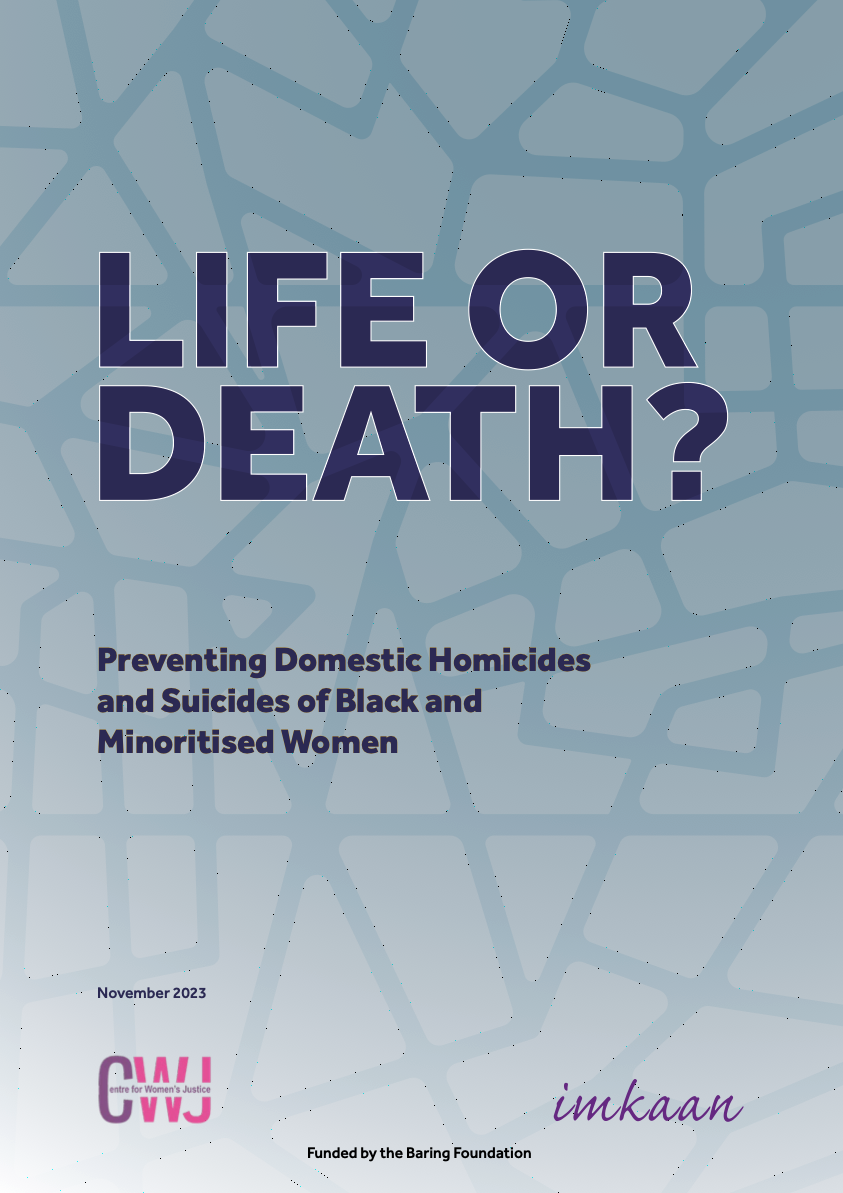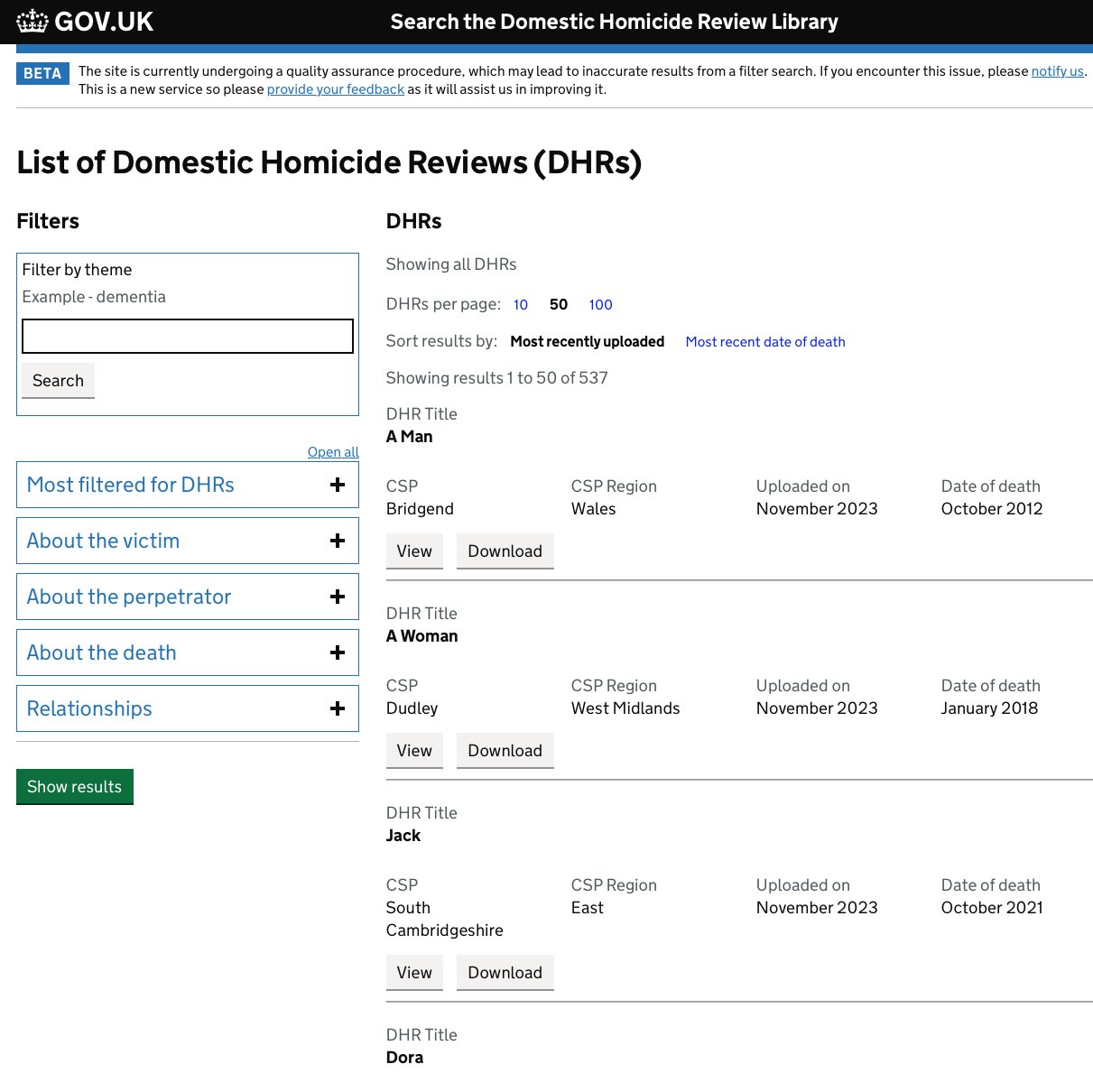Resources
Femicide Census 2022, Femicide Census, 2025
‘The Femicide Census is a unique source of comprehensive information about women who have been killed in the UK and the men who have killed them. Men’s violence against women is a leading cause of the premature death for women globally but research in the UK and Europe is limited and unconnected. The Femicide Census significantly improves upon currently available data by providing detailed comparable data about femicides in the UK since 2009, including demographic and social factors and the methods men selected to kill women. By collating femicides, we can see that these killings are not isolated incidents, and many follow repeated patterns.’
Family violence and women's deaths by suicide : A Victorian study, by Stefani Vasil, Kate Fitz-Gibbon and Marie Segrave, published by Australian Catholic University, Sequre Consulting and University of Melbourne, 2025
‘Women’s deaths by suicide in the context of family violence victimisation represent an important but often overlooked dimension of gender-based violence. Coroners and researchers in Australia and internationally are increasingly drawing attention to the intersection between women’s lived experiences of family violence and their heightened risk of suicide. Currently, suicides related to family violence, including women’s death by suicide in this context, are inconsistently counted in national statistics, obscuring the scale of the issue and limiting opportunities for targeted prevention and intervention.
In recent years, the Victorian coronial investigation process has revealed compelling evidence of the impact of family violence victimisation, in its myriad forms, on women’s mental health and wellbeing generally and suicidality specifically. Drawing on the views of a small group of experts, this report aims to offer insights to inform better understandings of the risk of suicide among women who have experienced family violence victimisation and opportunities to support investigative processes to account for the relationship between family violence and women’s deaths by suicide in Victoria. It also illuminates some of the opportunities for enhanced intervention and system responses across the family violence, mental health and justice systems.’
Learning from Loss, Dame Nicole Jacobs, Domestic Abuse Commissioner, 14 July 2025
‘For over 13 years, domestic homicide reviews have been gathering critical learnings from too many lives tragically lost. But despite bereaved families, the domestic abuse sector and myself calling for better accountability in our response to domestic abuse, there remains no process to ensure the important changes highlighted in these reviews are being implemented at a national and local level.
This report – which summarises a pilot project by my office to explore how we best monitor the implementation of recommendations and delivery of actions stemming from these reviews – has unearthed some stark and concerning findings.’
Never again. Again, by Alison Ashton, for Standing Together Against Domestic Abuse, June 2025
‘A review of health recommendations following a domestic abuse related death. Research and Analysis from all Domestic Abuse Related Death Reviews published in 2024.’
‘STADA reviewed all Domestic Homicide Reviews/Domestic Abuse Related Death Reviews published in 2024 and has found that 89% of them had at least one recommendation for health professionals or the health system. The reviews related to deaths over a period of nearly ten years. Many recommendations were repeated across several DHRs/DARDRs suggesting a lack of learning over time and between locations. STADA categorised the various recommendations and found that almost a quarter related to the need for ‘training and learning’ related to domestic abuse amongst healthcare professionals. The need for improved practice in the intersection between mental health and domestic abuse was another common theme.’
VKPP: Domestic Homicides and Suspected Victim Suicides 2022-2024 Year 4 Report, Home Office/VKPP/NPCC/College of Policing, 25 March 2025
The fourth annual report from the national Domestic Homicide Project, which works across England and Wales, examines all deaths identified by police as domestic abuse related to improve understanding of risk indicators, victim, and perpetrator demographics. The unique dataset collects detailed information on these deaths not available from any other source to help police and partners improve their response to domestic abuse, domestic homicide and victim suicide following domestic abuse. As well as providing detailed analysis of domestic abuse related deaths, the project also worked with bereaved families of victims, who continue to be a key driver for change across the criminal justice system.
Domestic Homicides and Suspected Victim Suicides 2022-2024 Year 4 Report
2000 Women, Femicide Census, March 2025
‘One dead woman is one woman too many – but here we have 2,000. Two thousand women whose lives were cut short by violent, controlling, angry, sadistic, sick and/or predatory men. Two thousand women, one killed in the UK, on average, every three days.’
‘It is the position of the Femicide Census that with sufficient will, we can and we must end men’s violence against women and girls. Two thousand women is two thousand women too many.’
VKPP: Domestic Homicides and Suspected Victim Suicides 2020-2023 Year 3 Report, Home Office/VKPP/NPCC/College of Policing, March 2024
The NPCC and College of Policing, working with the national policing Vulnerability Knowledge and Practice Programme (VKPP), devised the Domestic Homicide Project at the start of the Covid-19 pandemic and this is the third annual report. This research provides policing with unique insights from the analysis of domestic homicides, unexpected deaths and suspected victim suicides following domestic abuse, including twenty-three key findings and nine recommendations to improve the response to domestic abuse and aim to help prevent future deaths.
Domestic Homicides and Suspected Victim Suicides 2020-2023 Year 3 Report
Life or Death?, Imkaan and CWJ, November 2023
‘“Life or Death?” is a groundbreaking report created by Imkaan and the Centre for Women’s Justice (CWJ); the first of its kind to examine the deaths of Black and minoritised women as a result of domestic abuse. This research provides an in-depth analysis of 46 case studies of domestic abuse.
Poignantly, the initial release of this report coincided with the tragic murder of 35-year-old Black woman Perseverance Ncube, who was stabbed to death on November 10 in her Salford home, in front of her two young children. This report and its findings have never been so urgent, shining a spotlight on the systemic failures that continue to cost Black and minoritised women their lives.’List of Domestic Homicide Reviews, Home Office, updated November 2023
Search the domestic homicide review library: use this service to find and view domestic homicide review documents that are available to the public.
Domestic homicide reviews are done when the death of a person aged 16 or over has, or appears to have, resulted from violence, abuse or neglect by either: a relative; a spouse, partner or ex-partner; a member of the same household. This includes deaths by suicide. The purpose of a domestic homicide review is to: help identify lessons we can learn from the death; prevent further domestic abuse; improve services for victims of domestic abuse.
Report into Strangulation, Suffocation, Asphyxiation and Smothering Homicides in England and Wales from 2011 to 2021, by Dr. Gemma McKenzie, Institute for Addressing Strangulation (IFAS), September 2023
IFAS was established in 2022 to raise awareness of strangulation and suffocation. This includes highlighting the associated risks and dangers, and establishing best practice for professionals working with victims, survivors and their families. Although their work primarily focuses on strangulation, they see the parallels between this and suffocation, and are therefore developing their research and understanding of this area.
Research Briefing: Homicide Statistics, by Grahame Allen and Zoe Mansfield, House of Commons Library, 11 July 2023
Summary: 1 Homicides in England and Wales; 2 Characteristics of the victims of homicide; 3 Method of killing; 4 Sentencing and convictions for homicide; 5 Scotland and Northern Ireland; 6 International Comparisons; 7 Further reading
The Baroness Casey Review, Metropolitan Police, March 2023
A review into the standards of behaviour and internal culture of the Metropolitan Police Service.
Recognising the grave levels of public concern following the kidnap, rape and murder of Sarah Everard by a serving Met officer and other deeply troubling incidents, the Metropolitan Police Service (the Met) appointed Baroness Louise Casey to lead an independent review of its culture and standards of behaviour. The review began in February 2022 and completed in March 2023, when the final report and recommendations were published. The review: discusses whether the Met’s leadership, recruitment, vetting, training, culture and communications support the standards the public should expect; recommends how high standards can be routinely met, and how high levels of public trust in the Met can be restored and maintained.
Domestic Homicide Sentencing Review, HMSO, March 2023
The government commissioned an independent expert, Clare Wade KC, to review sentencing in domestic homicide cases to establish whether current law and sentencing guidelines are fit for purpose and identify options for reform.
The Domestic Homicide Sentencing Review was published in March 2023 alongside a package of proposed reforms to change the law so that sentencing reflects the seriousness of domestic homicides. The government will publish a full response to the Review in summer 2023.
Domestic Homicide Sentencing Review: Findings of the Initial Case Review, HMSO, March/April 2023
The initial Case Review looked in detail at a sample of domestic homicide cases and was used to inform Clare Wade KC’s Domestic Homicide Sentencing Review.
For this initial case review the sentencing remarks of 118 domestic homicide cases which were concluded in the courts between 2018 and 2020 and where the victim was a partner or ex-partner of the offender were analysed.
Our Sector, Our Voice, Our Work, Imkaan, March 2023
A Participatory Evaluation of the Comic Relief Supporting and Sustaining Specialism Programme for the Black & Minoritised women-led by and for sector (2022-2023). Imkaan has over twenty years’ experience of research and evaluation work in the specialist VAWG sector particularly framed at supporting Black and minoritised women and girls subject to VAWG and with an intersectional social justice approach. Imkaan has produced high quality pieces of research that have supported direct, positive changes in the policy, funding and commission landscape (https://www.imkaan.org.uk/research).
https://www.imkaan.org.uk/updates/2022/imkaan-comic-relief-report
Femicide Census: UK Femicides 2009-2018. “If I’m not in Friday, I might be dead”, Femicide Census
The Femicide Census is a unique source of comprehensive information about women who have been killed in the UK and the men who have killed them. Men’s violence against women is a leading cause of the premature death for women globally but research in the UK and Europe is limited and unconnected. The Femicide Census 10-year report significantly improves upon currently available data by providing detailed comparable data about femicides in the UK from 2009 to 2018, including demographic and social factors and the methods men selected to kill women. By collating femicides, we can see that these killings are not isolated incidents, and many follow repeated patterns.
Femicide Census 2020, Femicide Census, 2022
Released on 13th February 2022, the most recent annual femicide census is the most comprehensive study of the 110 women killed by men in the UK in 2020. Overall data trends remain broadly consistent with previous reports. On average, one woman is killed by a man every three days in the UK.
Homicide in England and Wales: year ending March 2022, Office for National Statistics, 2022
ONS analyses of information held within the Home Office Homicide Index, which contains detailed record-level information about each homicide recorded by police in England and Wales.
Domestic Abuse in England and Wales Overview: November 2022, Office for National Statistics, 2022
ONS figures on domestic abuse from the Crime Survey for England and Wales, police recorded crime and a number of different organisations.
Tackling Violence Against Women and Girls, HM Government, July 2021 (updated November 2021)
Policy paper. The document is the new strategy covering the government’s plan to tackle violence against women and girls. It covers how HMG will prioritise prevention, support survivors, pursue perpetrators and create a stronger system.
Intimate Partner Femicide: Using Foucauldian analysis to track an eight stage progression to homicide, Dr Jane Monckton-Smith, published in Violence Against Women, 26 (11), 2020, pp. 1267-1285
Research carried out by Dr Jane Monckton-Smith looked at 372 cases of intimate partner homicide through interviews with bereaved families and public protection professionals. Through her study, Monckton-Smith, Senior Lecturer in Criminology at the University of Gloucestershire, found an emerging pattern that could be broken down into eight separate stages. “The domestic homicide timeline is a pioneering model which transforms the way we think about domestic homicide, coercive control and stalking and the risks in these situations. This is the first time these behaviours have been organised in this way. Police have been incredibly receptive, and recognise the steps in cases they are working on, because it speaks to their experience and makes an order out of the chaos that is domestic abuse, coercive control and stalking. This will fundamentally change the way we look at risk and has the potential to save lives, as intervention is possible at every single stage and victims can use this to understand their own position.”
Domestic abuse is a gendered crime, Women’s Aid, 2021
Every case of domestic abuse should be taken seriously and each individual given access to the support they need. All victims should be able to access appropriate support. Whilst both men and women may experience incidents of inter-personal violence and abuse, women are considerably more likely to experience repeated and severe forms of abuse, including sexual violence. They are also more likely to have experienced sustained physical, psychological or emotional abuse, or violence which results in injury or death.
www.womensaid.org.uk/information-support/what-is-domestic-abuse/domestic-abuse-is-a-gendered-crime/
Centre for Women’s Justice Super-complaint, 19 March 2019
Police failure to use protective measures in cases involving violence against women and girls.
GLOBAL STUDY ON HOMICIDE Gender-related killing of women and girls, United Nations Office on Drugs and Crime, 2019
Constituting the fifth part of the Global Study on Homicide 2019, this booklet gives an overview of the scope of gender-related killing of women and girls. It provides in-depth analysis of killings perpetrated within the family sphere and examines forms of gender-related killings perpetrated outside the family sphere, such as the killing of women in conflict and the killing of female sex workers. The booklet explores the scale of intimate partner/family-related killings of women and girls, and describes different forms of gender-related killings of women. It also looks at the characteristics of the perpetrators of intimate partner killings, the link between lethal and non-lethal violence against women, and the criminal justice response.
























